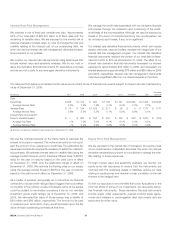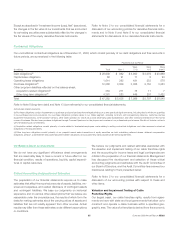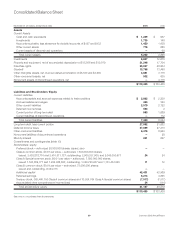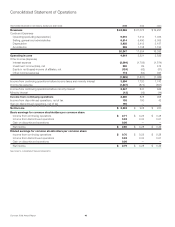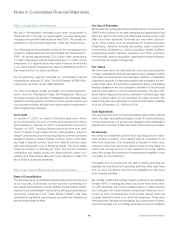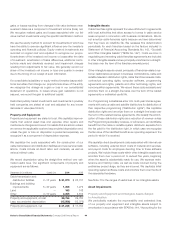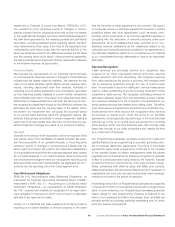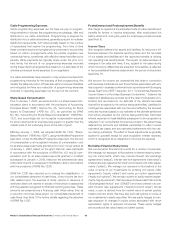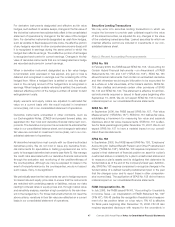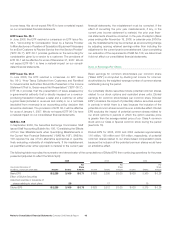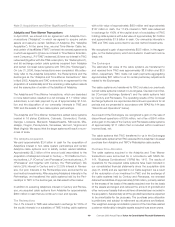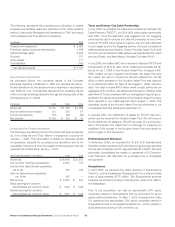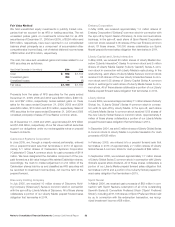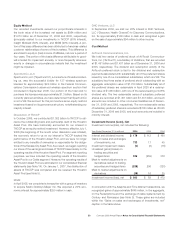Comcast 2006 Annual Report Download - page 45
Download and view the complete annual report
Please find page 45 of the 2006 Comcast annual report below. You can navigate through the pages in the report by either clicking on the pages listed below, or by using the keyword search tool below to find specific information within the annual report.
Notes to Consolidated Financial Statements
43 Comcast 2006 Annual Report
Note 1: Organization and Business
We are a Pennsylvania corporation and were incorporated in
December 2001. Through our predecessors, we have developed,
managed and operated cable systems since 1963. We classify our
operations in two reportable segments: Cable and Programming.
Our Cable segment is principally involved in the management and
operation of cable systems in the United States. As of December 31,
2006, we served approximately 23.4 million video subscribers,
11 million high-speed Internet subscribers and 2.4 million phone
subscribers. Our regional sports and news networks are included
in our Cable segment because they derive a substantial portion of
their revenues from our cable operations.
Our Programming segment operates our consolidated national
programming networks: E!, Style, The Golf Channel, VERSUS (for-
merly known as OLN), G4 and AZN Television.
Our other businesses consist principally of Comcast Spectacor,
which owns the Philadelphia Flyers, the Philadelphia 76ers and
two large multipurpose arenas in Philadelphia, and manages other
facilities for sporting events, concerts and other special events, and
our corporate activities. We also own equity method investments in
other programming networks.
Stock Split
On January 31, 2007, our Board of Directors approved a three-
for-two stock split in the form of a 50% stock dividend (the “Stock
Split”) payable on February 21, 2007, to shareholders of record on
February 14, 2007. The stock dividend was in the form of an addi-
tional 0.5 share for every share held and was payable in shares of
Class A common stock on the existing Class A common stock and
payable in shares of Class A Special common stock on the exist-
ing Class A Special common stock and Class B common stock
with cash being paid in lieu of fractional shares. Our stock began
trading ex-dividend on February 22, 2007. The number of shares
outstanding and related prices, per share amounts, share con-
versions and share-based data have been adjusted to reflect the
Stock Split for all periods presented.
Note 2: Summary of Significant Accounting Policies
Basis of Consolidation
The accompanying consolidated financial statements include (i) all
of our accounts, (ii) all entities in which we have a controlling vot-
ing interest (“subsidiaries”) and (iii) variable interest entities (“VIEs”)
required to be consolidated in accordance with generally accepted
accounting principles in the United States (“GAAP”). We have
eliminated all significant intercompany accounts and transactions
among consolidated entities.
Our Use of Estimates
We prepare our consolidated financial statements in conformity with
GAAP, which requires us to make estimates and assumptions that
affect the reported amounts and disclosures. Actual results could
differ from those estimates. Estimates are used when account-
ing for various items, such as allowances for doubtful accounts,
investments, derivative financial instruments, asset impairment,
nonmonetary transactions, certain acquisition-related liabilities,
programming-related liabilities, pensions and other postretire-
ment benefits, revenue recognition, depreciation and amortization,
income taxes and legal contingencies.
Fair Values
We have determined the estimated fair value amounts presented
in these consolidated financial statements using available market
information and appropriate methodologies. However, considerable
judgment is required in interpreting market data to develop the esti-
mates of fair value. The estimates presented in these consolidated
financial statements are not necessarily indicative of the amounts
that we could realize in a current market exchange. The use of dif-
ferent market assumptions and/or estimation methodologies may
have a material effect on the estimated fair value amounts. We
based these fair value estimates on pertinent information available
to us as of December 31, 2006 and 2005.
Cash Equivalents
The carrying amounts of our cash equivalents approximate their fair
value. Our cash equivalents principally consist of commercial paper,
money market funds, U.S. government obligations and certificates of
deposit with maturities of less than three months when purchased.
Investments
We review our investment portfolio each reporting period to deter-
mine whether a decline in the market value is considered to be
other than temporary. If an investment is deemed to have expe-
rienced an other than temporary decline below its cost basis, we
reduce the carrying amount of the investment to its fair market
value. We charge the impairment to earnings and establish a new
cost basis for the investment.
Purchases of or proceeds from the sale of trading securities are
classified as cash flows from operating activities, while cash flows
from all other investment securities are classified as cash flows
from investing activities.
We classify unrestricted publicly traded investments as available-
for-sale (“AFS”) or trading securities and record them at fair value.
For AFS securities, we record unrealized gains or losses resulting
from changes in fair value between measurement dates as a com-
ponent of other comprehensive income (loss), except when we
consider declines in value to be other than temporary. These other
than temporary declines are recognized as a component of invest-
ment income (loss), net. For trading securities, we record unrealized



